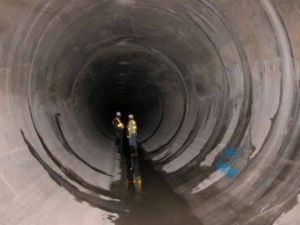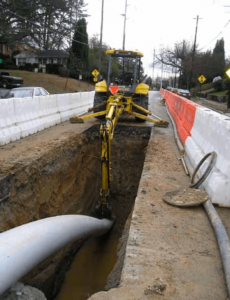Is That the Chattahoochee River?
By: Chattahoochee Riverkeeper
17 Years after lawsuit, the Atlanta waterway is cleaner than anyone remembers.
By Sally Bethea, Chattahoochee Riverkeeper
On a late-fall day in 2011, Alan Cressler, a U.S. Geological Survey scientist who has monitored water quality in Georgia’s Chattahoochee River twice a month for a decade, made what he regarded as an amazing discovery. He found a Southern rainbow mussel in the Chattahoochee River below Atlanta.
“I couldn’t believe it,” he said. “I never thought I would find a native mussel there.” For Cressler it was a sure sign that the nearly two-decades-long campaign to clean up the Chattahoochee has been worth the effort.

Massive sewage overflows routine
That effort represents one of the most successful enforcements of the Clean Water Act in the act’s 40-year history. By the 1970s, Atlanta’s sewer-system was so overloaded that every time it rained, raw sewage was discharged into city creeks and, ultimately, the river – leaving toilet-paper hanging in trees and human waste rotting in stagnant pools. City, state and federal environmental officials knew that this situation threatened public health, recreation and property values, but they did nothing.
In one old and densely settled section of the city, rain that flowed into storm drains was funneled into the same system that carried household and industrial sewage to treatment plants. During even small rain events, the sudden inflow of rainwater swamped the sewage treatment system and created combined sewer overflows (CSOs). The resulting mix of stormwater and untreated sewage flowed into creeks and rivers.
The rest of the city had problems even in dry weather. Decades of failure to maintain, repair and replace 1,500 miles of sewer lines were causing sanitary-sewer overflows (SSOs) that polluted neighborhood streams. And the city’s three sewage-treatment plants were not in much better shape than the pipes feeding them. In 1989, the city’s R. M. Clayton sewage treatment plant, the largest in the southeast, dumped 200 million gallons of raw sewage into the river during a storm. Massive spills such as this one were routine during the 1980s and ‘90s. By 1991, Greater Atlanta was beginning to wake up to the pollution that was flowing through city neighborhoods and downstream to other towns. The Atlanta Journal-Constitution published an article, accompanied by elaborate maps, entitled “Streams of Waste – Atlanta’s economic growth depends on its ability to save its urban waterways,” and in 1993 the City of Atlanta began paying daily fines for failing to comply with state legislative mandates – fines that would reach $20 million by the end of 1997.
Clean water lawsuit changes landscape
Then Upper Chattahoochee Riverkeeper (UCR) arrived. Co-founded by Laura Turner Seydel and Rutherford Seydel, it was approved in 1994 as the 11th licensed Waterkeeper group in the United States. (In 2012 the name was changed to Chattahoochee Riverkeeper.)
From the beginning it was clear that UCR’s biggest challenge would be to force the City of Atlanta to overhaul its sewer system and stop decades of chronic pollution of the Chattahoochee and its tributaries – although state officials had warned that this task would be far too expensive and, in fact, impossible.
Undaunted, UCR went about building a coalition of affected downstream parties, and, in the summer of 1995, this group of six local governments, two environmental organizations, a lake homeowners association, a chamber of commerce and two individuals sent a 60-day notice letter to the City of Atlanta, alleging violations of the Clean Water Act at the sewage facilities that discharged into the Chattahoochee River watershed. After receiving no response from the city or regulatory agencies, UCR and its co-plaintiffs filed a federal court suit in October 1995. UCR had clear goals in mind: a federal consent decree, specific deadlines for system upgrades, and compliance with water quality standards in the quickest, most cost effective and efficient manner.
As the case made its way through the judicial process, UCR continued to patrol the Chattahoochee and its tributaries, finding many sewage-spills and other contamination that were revealed in colorful, if disgusting, detail on the pages of the Journal-Constitution.
In early 1997, the U.S. Environmental Protection Agency decided to conduct a thorough investigation of the city’s entire sewage system and insisted that state environmental officials join the federal agency in what became a historic five-month joint-enforcement review. The regulators made unannounced visits to sewage plants and walked urban streams to determine the extent of the problem. The situation was even worse than anyone had expected.

Pollution ‘a matter of undisputed fact’
That year, Federal Judge Thomas Thrash issued an order in UCR’s favor on a summary judgment motion, finding that it was “a matter of undisputed fact that the CSO treatment facilities are dumping massive amounts of proscribed metals and fecal coliform into the tributaries of the Chattahoochee.”
The question became how Atlanta would fix its sewer system to meet federal water quality standards – and how the city and its 420,000 residents, 20 percent of whom were low-income, would fund the multi-billion dollar effort.
Shortly after the order was issued in the CSO lawsuit, the EPA offered to work with the State of Georgia’s environmental agency to help UCR settle the case. The agencies would then proceed on their own with a legal action to tackle the extensive SSO problems that also plagued the city.
In 1998, UCR and the regulators agreed to a settlement with the City of Atlanta requiring studies and analyses that would lead to a remedial-action plan for all of the city’s CSO facilities. The city committed to a deadline to meet water-quality standards at the CSO outfalls. In addition to a $2.5 million fine, the city agreed to remove every piece of trash from 37 miles of urban streams, and to invest $25 million in a greenway acquisition program for the purchase and permanent protection of stream side lands.

The “Sewer Mayor”
The new century brought a new and more environmentally responsible administration to Atlanta. In 2001, Shirley Franklin, the first African-American woman to become mayor of any major Southern city, was inaugurated. She talked so frequently about sewage issues that she even dubbed herself “The Sewer Mayor.” She also realized that the city’s drinking-water system was just as decrepit as its sewer system, and needed a major overhaul. She asked the president of the Georgia Institute of Technology to oversee a blue-ribbon panel of national experts to review the city’s proposed sewer cleanup plan, and when they approved it, she worked to fund upgrades of the sewer- and water-infrastructure – estimated to cost more than $3 billion.
The mayor and others, including Upper Chattahoochee Riverkeeper, conducted a long campaign to raise water and sewer rates to help pay for the improvements. The Atlanta City Council finally approved a substantial rate increase in 2004. It was, said one prominent leader of the Metro Atlanta Chamber of Commerce, one of the most important votes in Atlanta’s history. Later that year, the citizens overwhelmingly approved a one percent sales-tax increase for four years to help repair the sewers and clean up the Chattahoochee and its tributaries. That increase has now been re-approved twice by the voters, most recently in the spring of 2012.
Georgia’s Republican governor agreed to help Atlanta’s Democratic mayor and pledged $500 million in low-interest loans; however, neither the state nor federal government has provided other substantial financial assistance. The multi-billion-dollar clean-up program has fallen almost exclusively on the backs of city residents and businesses, who now pay Georgia’s highest local sales-tax and the country’s steepest water and sewer rates.
Cleaner Today
Today, 97 percent of the untreated sewage that flowed from Atlanta’s decrepit sewer system in the 1990s has been stopped, and the annual discharge of hundreds of billions of gallons of this contamination no longer threatens public health and environmental quality. By 2014, 99 percent of that volume will no longer flow into the area’s waterways, and all major capital improvement projects will have been completed at a cost of nearly $2 billion. All work on fixing Atlanta’s CSO problems, which were the impetus for UCR’s lawsuit, has been completed on time and under budget. As the result of two “supplemental environmental projects,” close to 1,900 acres of green space adjacent to waterways have been permanently protected. And Mayor Kasim Reed has credited the massive sewer overhaul for $18 billion in investments in Atlanta’s downtown.
But these are hard times. Stressed by the recession, repeated droughts and the high demands on its ratepayers, the city petitioned the EPA in 2010 for extra time to finish the remaining SSO upgrades, and it recently received an extension. This additional time will also make it easier for Atlanta to upgrade its’ drinking-water system. Given Atlanta’s good-faith efforts to date, UCR supported the extension.
After all, the Chattahoochee downstream of Atlanta is flowing cleaner today than it has in the memory of most Georgians now living. And birds, fish – and people – are coming back to the river.
You can read about Chattahoochee Riverkeeper’s continuing fight for the “Hooch” at chattahoochee.org